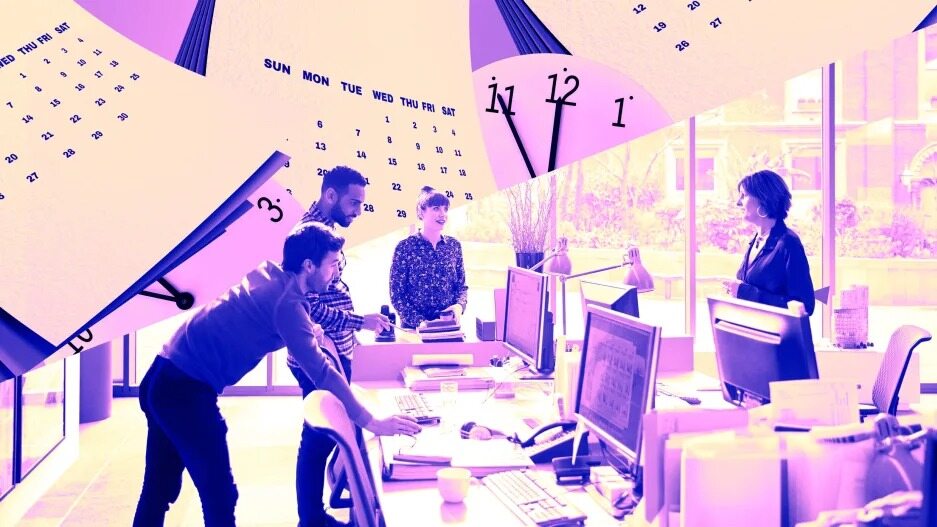- | 8:00 am
There won’t be a new normal—and that’s okay
Accept that change is constant, even if the pace is accelerating, and make it work for you.

There is a phrase coined by Peter Hinssen in his book The Phoenix and the Unicorn that absolutely nails the current state of our professional environment. Hinssen, a Belgian thought leader on radical innovation, discusses his thesis that the constant evolution and unprecedented pace of change we have faced isn’t going away anytime soon—in fact, it’s never going away. That phrase is “never normal.”
While this may feel daunting, it shouldn’t. Because “never normal” gives us an opportunity to improve, to challenge ourselves, and to further enhance the positive impact we can make as leaders.
Though the pace of change has accelerated in recent years, constant change is not a new idea. Before I took on the CEO role and was leading different areas of our business, I operated under the mantra, “the only thing constant is change itself.” Since then, we have continued to operate in a dynamic and evolving time, and recently I have seen firsthand how this acceleration of change, and our response to it, has helped to make us a stronger organization. Here are a few specific examples that illustrate this.
A CULTURE OF ALWAYS LOOKING AROUND THE CORNER
Consumer preferences are evolving today as frequently and quickly as ever. In fact, today it’s not enough to stay on top of trends—you must be ahead of them.
At Smucker, we encourage a spirit of constant curiosity to deliver on the wide-ranging needs of consumers who trust us for coffee, pet food, and snacks, fruit spreads, frozen handheld foods, and more. We encourage our people to be highly engaged with the world outside our four walls—to study our customers, our industry, and the broader business environment. All of this in service of becoming a better company, competing more effectively, and ultimately better serving our end consumers.
To address the needs of those end consumers, we have invested significantly in data and analytics to ensure we have a deep understanding of them and how their preferences evolve. These insights go beyond guiding our own product development, however; they also help us continue to support the growth of our existing categories.
The commercialization team shares intelligence with our retail customers to help them maximize shelf space. Our guidance reflects insights based on buying patterns and gets store-level granular to show how regionality and shopper demographics offer useful insights on the best way to merchandise a store aisle. As a result, we have become a trusted partner of many retailers who recognize our sincere desire to promote mutual success. They value the unique intelligence we provide to help ensure it.
We do realize that patterns and habits change constantly, so our work is never done—but we like that. It allows us to leverage the spirit of curiosity that we hope to inspire. And it offers a reminder that if we aren’t thinking about what our consumers will need tomorrow, we won’t have the solution when tomorrow comes.
BE DEDICATED TO A VISION, BUT WILLING TO ADAPT
The continued discussion around workplace policies seems to be missing the bigger picture. No matter how confident we are in our vision for the workplace, we must constantly evaluate and be prepared to pivot as the environment dictates.
Right now, the hybrid model has been adopted, in some form, by many organizations. Based on a recent report from Littler Mendelson PC, more than 70% of U.S. employers are now embracing hybrid work models. While this seems to reflect the current majority position, how these hybrid models are delivered often differs greatly. And there really is no proven formula, it must be based on an organization’s needs and its employees.
As we looked at how to address the evolving workplace at Smucker, it was important to us to deliver on our employees’ needs and expectations while enabling collaboration and supporting continued productivity to deliver our business objectives.
To realize this, our corporate workplace model is focused on the idea of presence with purpose. We plan around core weeks—typically two weeks per month—during which we expect employees to be in the office two to three days. During these weeks, we strategically schedule events and meetings, including business updates, planning meetings, social hours, and food trucks, and seek to create meaningful opportunities for our people to connect and collaborate.
Importantly, we want to ensure employees don’t feel they are checking a box by being in the office for an arbitrary number of days. Instead, we are encouraging meaningful in-office presence, a time when most employees can be together and continue to nurture and build relationships that are part of the “glue” in a healthy corporate culture. To us, true flexibility isn’t simply establishing a specific number of days in the office, and we have approached the development of our model based on guiding principles, not rules.
The feedback has been positive. Employees have shared an appreciation for the balance, providing the flexibility they desire with a consistent opportunity to engage with colleagues face-to-face, which also remains important to them.
While we are pleased with the results of the model to date, we will continue to evaluate it. That evaluation will include talking with our employees to get their candid feedback and to understand what’s working, what isn’t, and what’s changed. And that underlies the key point: We must be confident in our vision, yet willing to adjust as needed to continue to achieve it.
AGILITY IS THE NEW STABILITY
In a world of constant change, to stand still is to fall behind. One thing these past few years have shown us plainly is the necessity of agility.
As we are all likely aware, supply chain constraints became exceedingly challenging during the pandemic. To continue to deliver for our customers and consumers, we had to be diligent and willing to think outside the box to come up with solutions to problems that, in many instances, we hadn’t previously encountered at scale.
This required not just our own flexibility, but that of our suppliers as well. There were countless examples of this: from eschewing historic branding on certain packaging to keep products on shelves, to reformulating to meet inventory needs while delivering the quality consumers expect. And many of these short-term solutions have had longer-term benefits as we think about continued productivity and efficiency.
Most important, overcoming these challenges showed us that agility is a constant need, and that building our organizations to prepare for this is be essential. Simply put, if we cultivate an environment to address change, we will be well positioned to do so when the changes inevitably come.
The “never normal” we face has taught us many lessons. For myself, this dynamic environment reminds me to lead with a spirit of courage and curiosity, to be unwavering in our values but willing to evolve how we bring them to lif,e and to be agile in the face of change.
None of us knows what tomorrow holds; I certainly don’t. But I am confident in our ability to lead our industries, our organizations and our communities through whatever may come.







































